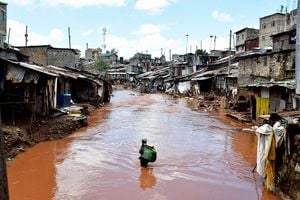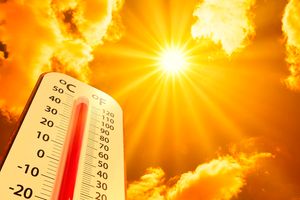Landmark report reveals extent of climate impacts in Kenya

The report, a comprehensive assessment of the cascading impacts of climate change on Kenya’s society and economy dubbed ‘What climate change means for a country and its people’- shows that Kenya needs to take immediate actions to enable individuals in different parts of the country to adapt to the changing climate.
What you need to know:
- How increasing temperatures, droughts, extreme floods and landslides pose a growing threat to biodiversity and human lives.
Earlier this week, Immaculate Ntalalai took an eventful trip from her home in Olooloitokoshi, Kajiado County, to Nairobi. On a typical weekday, you would have found her working on an eight-acre parcel of land, a shared resource that she and other women have transformed into a source of livelihood.

Immaculate Ntalalai, a resident of Kajiado County and member of Nadupoi Women Group, talks about the negative impacts of climate change to her community on July 24 during the launch of a climate change impacts report in Nairobi.
For Immaculate, climate change is a lived reality. She comes from one region that partly comprises 80 per cent of Kenya’s arid and semi-arid lands. Over the years, the country has been experiencing longer dry seasons, worsening the already dire situation in those areas.
Immaculate traces the origin of her intimate connections with the impacts of climate change to her childhood. Growing up, amid subtle shifts in weather patterns, she knew that something was happening around her community. Yet, life went on, marked by the rhythms of planting, harvesting and pastoralism. It was the 2020 drought, which parched the land and shattered livelihoods, that jolted her into the stark reality of climate change.
The World Meteorological Organization (WMO) said the drought was the worst to be experienced in the East African region in 40 years. For Immaculate and her neighbours, the drought was a hungry monster at their doorsteps.
“We have come face to face with the negative impacts of climate change. In 2022 for instance, we lost cows, which were our main source of livelihood. The heavy rainfall obliterated the roads and spoilt our harvests. We were on the verge of losing hope,” she said.
As a member of the Nadupoi women’s group, a collective of women fighting against climate change, Immaculate was used to the quiet determination of their daily struggle. Until Wednesday. For the first time, she stepped into the spotlight.
“I haven’t taken to the stage before. But, I am here because of what we have gone through and how we are adapting to ensure that we have something for other generations,” she said.
She was among hundreds of individuals—climate scientists, policymakers, activists, and representatives from indigenous communities—who had converged in the capital to witness the unveiling of a report that exposed the climate impacts in Kenya.
The report, a comprehensive assessment of the cascading impacts of climate change on Kenya’s society and economy dubbed ‘What climate change means for a country and its people’- shows that Kenya needs to take immediate actions to enable individuals in different parts of the country to adapt to the changing climate.
It also exposes the need for continuous climate-related data collection, which will help the government to develop data-backed policies.
The report is spearheaded by scientists from the Kenya Meteorological Department (KMD) and co-authored by those from the World Resources Institute and Climate Analytics.
The findings show that in 2022 alone, a prolonged drought that had mainly affected the Horn of Africa region triggered a countrywide fall in maize production of 6.5 per cent and a 3.3 per cent drop in the volume of horticultural exports such as cut flowers.
The report records that some of the worst episodes of drought witnessed in the country were in the years 2006, 2010/2011, 2016/2017 and 2020 to 2023.
The researchers analysed different climate-related data sets in Kenya and established that while there is limited data specifically on rainfall patterns, climate change increased the intensity of rainfall in the short rainy season in the Horn of Africa in 2023. During that period, which extended to early this year, its impacts such as flash floods left hundreds dead and thousands displaced from their homes. At least 37 counties were affected.
The scientists show that in the long rainy season, however, there has been a long-term drying trend.
The analysis shows that since 2005, droughts have doubled in frequency. Previously, they occurred once every six years, but now they occur once every three years in East Africa.
The report shows that climate change has made events like the extreme drought that the country has been experiencing since 2020 stronger and about 100 times more likely to happen.
Other sectors such as fishing had a positive outcome. Fish production increased by 4.5 per cent from 2021 to 2022. “This increase is significantly positive since the fishing industry in Lake Victoria directly employs about 200,000 people and supports the livelihoods of about four million people,” reveal the findings.
Patricia Nying’uro, a co-author of this report and Kenya’s focal point for the Intergovernmental Panel on Climate Change, said development of the report was inspired by the need to come up with a simple document that is accessible to everyone.
“We want to help policymakers and relevant stakeholders to have something right on their hands, something that they can quickly refer to on issues of climate change,” she said.
Young people aged 34 years and below make up the majority of Kenya’s population. While a youthful nation provides momentum to spur growth, the authors note that it makes the protection of natural resources a pressing concern.
According to World Weather Attribution, rapid urbanisation partly contributed to the disastrous floods last year.
“As our cities grow and evolve, the decisions we make today about urban development will shape the lives of millions of Africans and determine the sustainability of our cities and livelihoods for generations to come. Africa is urbanising at an unprecedented rate. By 2050, it is estimated that more than half of the continent’s population will live in cities. For Africa, the climate conversation is also a development conversation, which must be a top priority, and this is why this report comes at such a good time. Climate and land use transformation threaten the interdependent infrastructure systems crucial for Kenya’s future,” said Nasra Nanda, chairperson of Africa Regional Network and CEO Kenya Green Building Society, who wasn’t involved in the report.
She added: Our water, energy and food infrastructures face increasing risks from recurrent droughts and flash floods, challenging us to innovate and adapt for a resilient tomorrow, and this can only be done by looking at the built environment as an ecosystem of opportunities and challenges that will help or harm communities, businesses and governments in a rapidly changing world.”
In the recent seven days of weather forecast by KMD, most parts of the country will experience cold and cloudy conditions, with Lodwar forecasted to receive the maximum temperature of 36 degrees Celcius.
“On this report and during its launch, I emphasised creating heat awareness. With the warming of our planet, we are expecting to see days that are hotter than normal,” said Dr Joyce Kimutai, a climate scientist with KMD and Imperial College London, also a co-author of the report.
Between 1973 and 2013, the East African region recorded a temperature increase from 0.7 degrees celsius to about 1 degrees celsius. This comes at a time when latest data from the European Copernicus Climate Change Service shows that the world has already surpassed the dreaded 1.5 degrees celsius mark. The latest preliminary satellite data shows that July 21 this year was the hottest day ever recorded in history.
“Looking ahead, projections suggest the temperature will continue to rise in East Africa. With a global temperature rise of 1.5 degrees celsius above pre-industrial levels, the average annual temperature in the region is projected to rise 0.6 degrees celsius above the 1994–2005 average,” the researchers predict.
With the temperature increase and gloomy prediction in the region, Kenya has continued to face the impacts of climate change in different ways.
Intense rainfall is expected to increase in most regions in Africa. The findings indicate that children born in 2020 could be exposed to three to five times more heatwaves in their lifetimes than those born in 1960, even if global temperature rise is limited to 1.5 degrees celsius. Should there be a global temperature rise of 2.4 degrees celsius, the same children would be exposed to four to nine times more heatwaves.
Glaciers on Mount Kenya are currently estimated to cover just 4.2 per cent of their total area in 1900 and are projected to disappear by 2030 under all climate scenarios. This despite 70 per cent of the country’s hydropower coming from the same glaciers.
In 2018, data shows that 79 per cent of international public climate finance into Kenya was in the form of debt, with more than half of that money channelled towards mitigation.
Peter Odhengo, Head of Climate Finance and Green Economy Unit and FLOCCA Programme Coordinator at the National Treasury, emphasised the need for citizen engagement and local leadership.
At the launch of the report, he said the average amount of money meant for climate finance in the 47 counties is about Sh100 million. “This amount will also be given next year as well as the subsequent one,” he promised.
Environment, Climate Change and Forestry PS Festus Ng’eno said it is crucial to prioritise equity in our climate initiatives as vulnerable communities are the most affected by climate impacts.
“There is a need to increase funding for research that contextualises global model outputs, sector-specific costs of climate impacts, the cost of inaction, and the role of local and indigenous knowledge, among other factors, if we are to adequately adapt to impacts of the changing climate , especially at the local level,” he said.
This report highlights the urgent need for adaptation in Africa. Already, Immaculate and some of her community members who are traditionally pastoralists have started embracing fish farming, bee keeping and chicken rearing as an alternative source of livelihood.






